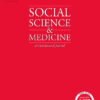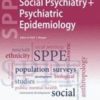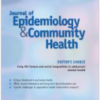News

Perceived neighbourhood characteristics and depressive symptoms
Background: Multiple neighbourhood characteristics have been linked to depressive symptoms. However, few studies have simultaneously considered multiple mechanisms that explain this relationship, and how they might interact. Further, most studies regard exposure to the residential environment as constant, and therefore disregard variation in exposure by individual factors. This study investigates whether and to what extent…
Read more
Greenery exposure and suicide mortality
Background: Exposure to residential greenery accumulates over people’s lifetimes, and possibly has a protective association with suicide later in life. Objectives: To examine the associations between suicide mortality and long-term residential greenery exposure in male and female adults. Methods: Our population-based nested case-control study used longitudinally georeferenced Dutch register data. Suicide cases aged 18–64 years…
Read more
Outdoor light at night, air pollution and depressive symptoms
Background: Artificial light at night (ALAN) may be an anthropogenic stressor for mental health disturbing humans’ natural day–night cycle. However, the few existing studies used satellite-based measures of radiances for outdoor ALAN exposure assessments, which were possibly confounded by traffic-related air pollutants. Objective: To assess 1) whether living in areas with increased exposure to outdoor…
Read more
How important are perceived physical and social neighborhood characteristics on depression?
The physical and social neighborhood environments are increasingly recognized as determinants for depression. There is little evidence on combined effects of multiple neighborhood characteristics and their importance. Our aim was (1) to examine associations between depression severity and multiple perceived neighborhood environments; and (2) to assess their relative importance. Cross-sectional data were drawn from a…
Read more
Is suicide mortality associated with neighbourhood social fragmentation and deprivation? A Dutch register-based case-control study using individualized neighbourhoods.
In a study forthcoming in Journal of Epidemiology and Community Health we examined whether suicide mortality is associated with neighbourhood social fragmentation and socioeconomic deprivation using individualized neighbourhoods. Using longitudinal Dutch register data, we applied a nested case-control design matching all suicides among persons aged 18-64 years between 2007 and 2016 to 10 random controls…
Read more
The effect of short-term exposure to the natural environment on depressive mood: A systematic review and meta-analysis
Research suggests that exposure to the natural environment can improve mood, however, current reviews are limited in scope and there is little understanding of moderators. We aimed to conduct a comprehensive systematic review and meta-analysis of the evidence for the effect of short-term exposure to the natural environment on depressive mood. Five databases were systematically…
Read more
NEEDS study protocol published in BMJ Open
Environmental exposures are intertwined with mental health outcomes. People are exposed not only to the environments in which they currently live, but also to a multitude of environments along their daily movements and through their residential relocations. However, most research assumes that people are immobile, disregarding that such dynamic exposures also serve as stressors or…
Read more
Spatiotemporal Contextual Uncertainties in Green Space Exposure Measures: Exploring a Time Series of the Normalized Difference Vegetation Indices
Environmental health studies on green space may be affected by contextual uncertainties originating from the temporality of environmental exposures and by how the spatial context is delimitated. The Normalized Difference Vegetation Index (NDVI) is frequently used as outdoor green space metric capturing the chlorophyll content in the vegetation canopy. This study assessed 1) whether residential…
Read more
Is deep learning-based street view green and blue space beneficial for geriatric depression?
The paper, co-authored by Yao Yao, Ye Liu, Jinbao Zhang, Penghua Liu, and Ruoyu Wang, will be published in the journal Environment International. Residential green and blue spaces may be therapeutic for the mental health. However, solid evidence on the linkage between exposure to green and blue spaces and mental health among the elderly in non-Western…
Read more
The impact of social capital, land use, air pollution and noise on individual morbidity in Dutch neighbourhoods
Under the lead of Jan-Paul Zock (RIVM) a new paper was published in the flagship journal Environment International. Both social and physical neighbourhood factors may affect residents’ health, but few studies have considered the combination of several exposures in relation to individual health status. To assess a range of different potentially relevant physical and social…
Read more
